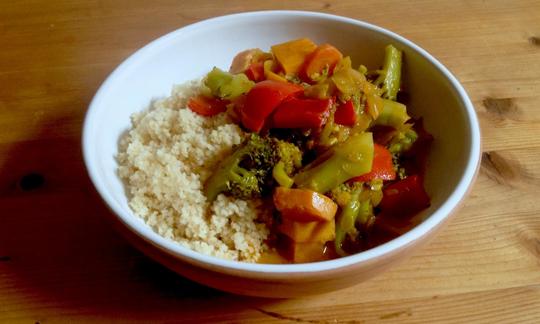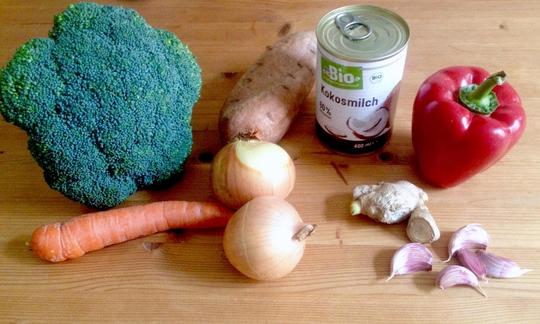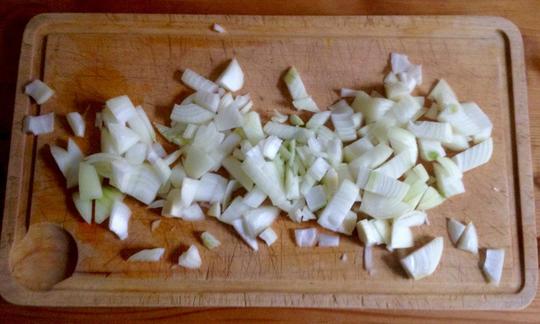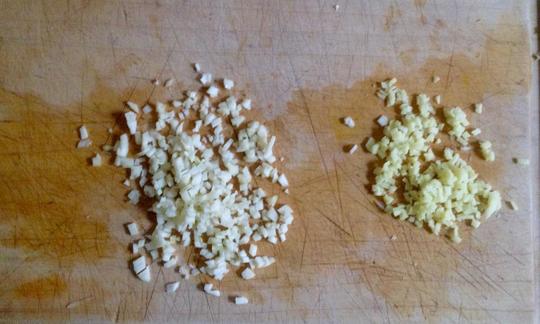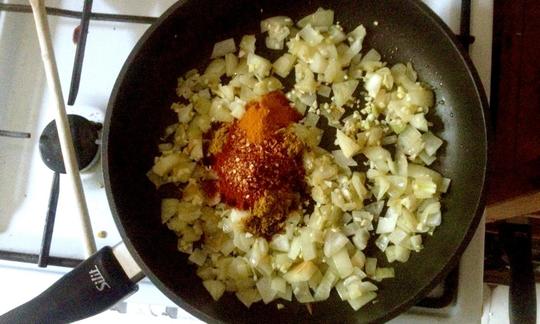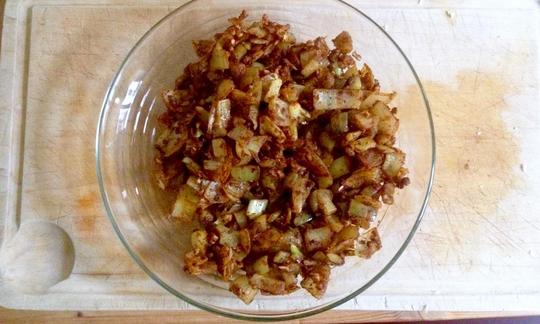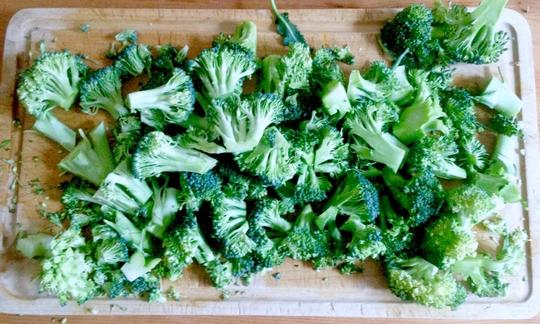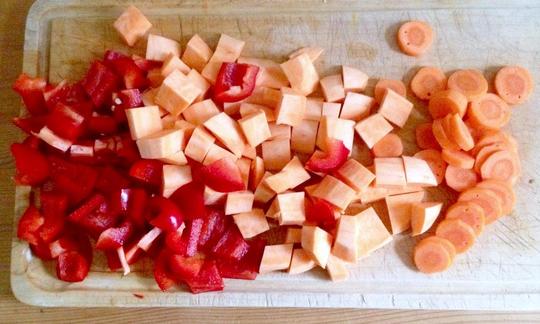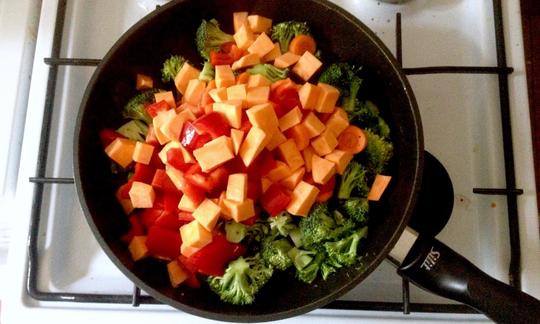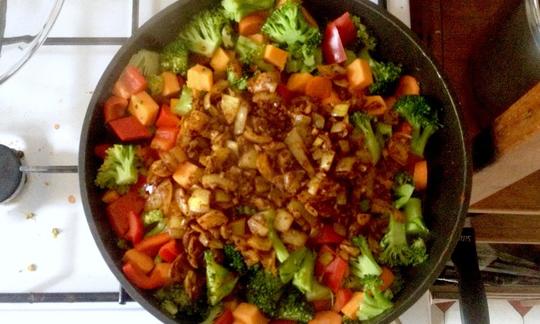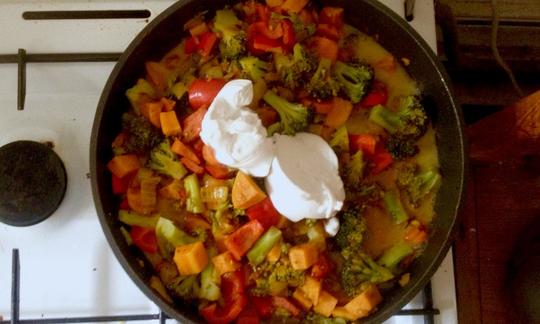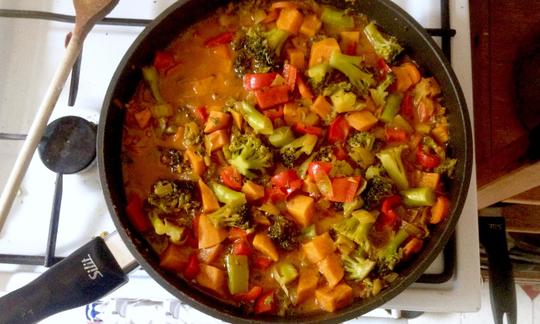Vegan vegetable curry with broccoli and sweet potatoes
vegan
Ingredients (for servings, )
| For the onion-spice mixture | |
|---|---|
| 2 | Onions, raw (organic?) (7.7 oz) |
| 2 tbsp | Rapeseed oil (canola, HOLL oil, kernel oil), cold pressed?, organic? (0.98 oz) |
| ¼ oz | Ginger, raw (organic?) |
| 5 cloves | Garlic (organic?) (0.53 oz) |
| 1 tbsp | Curry powder (organic?, raw?) (0.21 oz) |
| 1 tbsp | Paprika powder, hot (raw?, organic?) (0.24 oz) |
| 1 tsp | Chili powder (raw?, organic?) (0.09 oz) |
| 1 tsp | Turmeric (saffron root), ground, raw (organic?) (0.11 oz) |
| For the remaining ingredients of the Thai curry | |
| 18 oz | Broccoli, flower bunch (head), raw |
| 11 oz | Sweet potatoes, raw |
| 1 | Sweet peppers, red, raw (organic?) (5.8 oz) |
| 1 | Carrots (carrots), raw (organic?) (2.1 oz) |
| 1 tbsp | Rapeseed oil (canola, HOLL oil, kernel oil), cold pressed?, organic? (0.49 oz) |
| 200 ml | Coconut milk, preserved (coconut milk, organic?) (6.7 oz) |
| 200 ml | Drinking water, raw (organic?) (7.0 oz) |
| 1 dash | Sea salt (raw?, organic?) (0.01 oz) |
Equipment
- vegetable peeler
- skillet (frying pan)
- stove
Type of preparation
- cook
- sauté
- meld
- remove the skin
- peel
Preparation
For the onion-spice mixture
First, peel the onions and chop roughly. Heat the rapeseed oil slightly in a large pan or wok and add the onions. Sauté over a low heat until translucent.Peel the garlic and ginger and chop very finely. Add to the onions.
At this point, the onions should already be translucent. Make sure that the pan does not heat up too much - the onions should not turn brown, just have a soft consistency. The garlic also burns very quickly.
After about 5 minutes of sautéing, add curry powder, paprika powder, chili powder or flakes and turmeric to the onion mixture. Stir and leave to simmer on low heat for 3 minutes. Then pour into a bowl and set aside.
For the remaining ingredients of the vegetable curry
Wash the broccoli, sweet potato, carrot and pepper and cut into bite-sized pieces.You should peel the sweet potato before cutting it, as the skin becomes leathery during the cooking process. With carrots, especially organically grown products, you are free to do as you please.
At this point it makes sense to prepare the desired side dish.
Heat the rapeseed oil slightly in the pan or wok you used previously and add the vegetables. Fill with water so that the bottom is covered by about 1 cm. If possible, put the lid on and let it cook for 10 minutes.
After 10 minutes, check whether there is still water under the vegetables. If not, top up. Add the onion and spice mixture and stir. Replace the lid and cook for a few more minutes, depending on the desired consistency of the vegetables.
Continue to check occasionally whether there is still enough water on the bottom and whether the vegetables are ready. They should remain slightly firm.
As soon as the vegetables are cooked but still firm, add coconut milk and water. Season with salt, stir and bring to the boil briefly.
Depending on how warm the coconut milk was stored, it will have a different consistency. In colder areas, it often separates into a solid and a liquid part, but this does not say anything about its quality. You can also put both parts separately in the pan, because the solid part quickly melts under heat and combines with the liquid again.
Arranging and Serving
Arrange the vegetable curry on or next to the side dish on a plate and serve.
|
Nutritional Information per person
Convert per 100g
|
2000 kcal | |
|---|---|---|
| Energy | 348 kcal | 17.4% |
| Fat/Lipids | 22 g | 31.4% |
| Saturated Fats | 10 g | 50.1% |
| Carbohydrates (inc.dietary fiber) | 36 g | 13.3% |
| Sugars | 10 g | 11.2% |
| Fiber | 9.3 g | 37.0% |
| Protein/Albumin | 7.9 g | 15.8% |
| Cooking Salt (Na:153.2 mg) | 389 mg | 16.2% |
| Essential micronutrients with the highest proportions | per person | 2000 kcal | |
|---|---|---|---|
| Vit | Vitamin C (ascorbic acid) | 177 mg | 222.0% |
| Vit | Vitamin A, as RAE | 1'026 µg | 128.0% |
| Vit | Vitamin B9, B11 (Folate, as the active form of folic acid) | 138 µg | 69.0% |
| Min | Manganese, Mn | 1.4 mg | 68.0% |
| Vit | Vitamin K | 49 µg | 65.0% |
| Fat | Alpha-Linolenic acid; ALA; 18:3 omega-3 | 1.2 g | 58.0% |
| Elem | Potassium, K | 1'087 mg | 54.0% |
| Vit | Vitamin B6 (pyridoxine) | 0.68 mg | 48.0% |
| Min | Copper, Cu | 0.38 mg | 38.0% |
| Prot | Tryptophan (Trp, W) | 0.09 g | 38.0% |
Detailed Nutritional Information per Person for this Recipe
The majority of the nutritional information comes from the USDA (US Department of Agriculture). This means that the information for natural products is often incomplete or only given within broader categories, whereas in most cases products made from these have more complete information displayed.
If we take flaxseed, for example, the important essential amino acid ALA (omega-3) is only included in an overarching category whereas for flaxseed oil ALA is listed specifically. In time, we will be able to change this, but it will require a lot of work. An “i” appears behind ingredients that have been adjusted and an explanation appears when you hover over this symbol.
For Erb Muesli, the original calculations resulted in 48 % of the daily requirement of ALA — but with the correction, we see that the muesli actually covers >100 % of the necessary recommendation for the omega-3 fatty acid ALA. Our goal is to eventually be able to compare the nutritional value of our recipes with those that are used in conventional western lifestyles.
| Essential fatty acids | per person | 2000 kcal |
|---|---|---|
| Alpha-Linolenic acid; ALA; 18:3 omega-3 | 1.2 g | 58.0% |
| Linoleic acid; LA; 18:2 omega-6 | 2.4 g | 24.0% |
| Essential amino acids | per person | 2000 kcal |
|---|---|---|
| Tryptophan (Trp, W) | 0.09 g | 38.0% |
| Threonine (Thr, T, irreversibly transaminated) | 0.29 g | 32.0% |
| Isoleucine (Ile, I) | 0.28 g | 22.0% |
| Valin (Val, V) | 0.36 g | 22.0% |
| Lysine (Lys, K, irreversibly transaminated) | 0.36 g | 19.0% |
| Phenylalanine (Phe, F) | 0.30 g | 19.0% |
| Leucine (Leu, L) | 0.40 g | 17.0% |
| Methionine (Met, M) | 0.10 g | 11.0% |
| Vitamins | per person | 2000 kcal |
|---|---|---|
| Vitamin C (ascorbic acid) | 177 mg | 222.0% |
| Vitamin A, as RAE | 1'026 µg | 128.0% |
| Vitamin B9, B11 (Folate, as the active form of folic acid) | 138 µg | 69.0% |
| Vitamin K | 49 µg | 65.0% |
| Vitamin B6 (pyridoxine) | 0.68 mg | 48.0% |
| Vitamin E, as a-TEs | 4.0 mg | 33.0% |
| Vitamin B5 (Pantothenic acid) | 1.7 mg | 28.0% |
| Vitamin B1 (Thiamine) | 0.23 mg | 21.0% |
| Vitamin B2 (Riboflavin) | 0.29 mg | 21.0% |
| Vitamin B3 (Niacin) | 2.5 mg | 16.0% |
| Vitamin B7 (Biotin, ex vitamin H) | 5.6 µg | 11.0% |
| Essential macroelements (macronutrients) | per person | 2000 kcal |
|---|---|---|
| Potassium, K | 1'087 mg | 54.0% |
| Phosphorus, P | 217 mg | 31.0% |
| Magnesium, Mg | 96 mg | 26.0% |
| Sodium, Na | 153 mg | 19.0% |
| Calcium, Ca | 136 mg | 17.0% |
| Essential trace elements (micronutrients) | per person | 2000 kcal |
|---|---|---|
| Manganese, Mn | 1.4 mg | 68.0% |
| Copper, Cu | 0.38 mg | 38.0% |
| Iron, Fe | 4.7 mg | 34.0% |
| Zinc, Zn | 1.5 mg | 15.0% |
| Iod, I (Jod, J) | 21 µg | 14.0% |
| Selenium, Se | 6.0 µg | 11.0% |
| Fluorine, F | 39 µg | 1.0% |
Simple basic recipe for a vegetable curry (without side dish), the ingredients of which can be varied as desired. Here with broccoli, sweet potatoes and coconut milk.
Nutrient profile: According to GDA guidelines, one portion of this recipe covers more than the average daily requirement of vitamin A and twice the daily requirement of vitamin C. It is also rich in manganese and folic acid. The ratio of omega-6 to omega-3 fatty acids is 2:1, which is below the recommended maximum ratio of 5:1.
Curries: Curries are very popular and common dishes in Asia and there are countless variations. There are as many preparation methods, components, tastes, etc. as there are different regions in Asia. What they have in common is that they usually contain a lot of vegetables and are served with rice as a side dish.
This vegetable curry recipe does not claim to show a traditional preparation method and is therefore not an Asian dish in the true sense of the word. It should rather be seen as a kind of translation for a Western (German) palate.
Spiciness: The dish has a slight spiciness due to the ginger, curry and chili powder. If you like it less spicy or spicier, you can easily adjust it accordingly.
Vegetable alternatives: You can also use yellow peppers, zucchini, spinach, potatoes, pumpkin, spring onions or mushrooms. So it's also an excellent leftover meal if you have vegetables in the fridge that need to be used up.
Cashew nuts: Cashew nuts or peanuts are ideal as a protein-rich filling. You can add them whole or chopped to the pan with the vegetables. They cook relatively softly, with a delicate bite, and have hardly any taste of their own, so they absorb the taste of the curry wonderfully.
Possible side dishes: The traditional side dish for curry is Rice. Couscous, millet or quinoa also go well with this curry.
Fresh chili: If you like it spicy, fresh chili is particularly suitable.

